FluWatch report: November 10 to 16, 2019 (week 46)
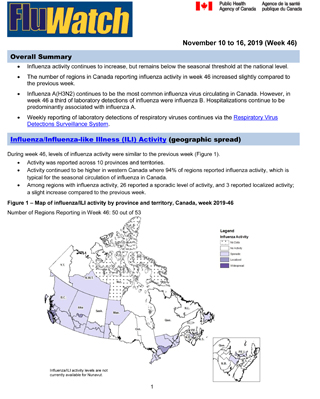
Download the alternative format
(PDF format, 464 KB, 9 pages)
Organization: Public Health Agency of Canada
Date published: 2019-11-22
Related Topics
Overall Summary
- Influenza activity continues to increase, but remains below the seasonal threshold at the national level.
- The number of regions in Canada reporting influenza activity in week 46 increased slightly compared to the previous week.
- Influenza A(H3N2) continues to be the most common influenza virus circulating in Canada. However, in week 46 a third of laboratory detections of influenza were influenza B. Hospitalizations continue to be predominantly associated with influenza A.
- Weekly reporting of laboratory detections of respiratory viruses continues via the Respiratory Virus Detections Surveillance System.
On this page
- Influenza/ILI Activity (geographic spread)
- Laboratory Confirmed Influenza Detections
- Syndromic/Influenza-like Illness Surveillance
- FluWatchers
- Influenza Outbreak Surveillance
- Severe Outcomes Influenza Surveillance
- Influenza Strain Characterizations
- Antiviral Resistance
- Vaccine Monitoring
- Provincial and International Influenza Reports
Influenza/Influenza-like Illness Activity (geographic spread)
During week 46, levels of influenza activity were similar to the previous week (Figure 1).
- Activity was reported across 10 provinces and territories.
- Activity continued to be higher in western Canada where 94% of regions reported influenza activity, which is typical for the seasonal circulation of influenza in Canada.
- Among regions with influenza activity, 26 reported a sporadic level of activity, and 3 reported localized activity; a slight increase compared to the previous week.
Figure 1 – Map of influenza/ILI activity by province and territory, Canada, week 2019-46
Number of Regions Reporting in Week 46: 50 out of 53

Figure 1 - Text equivalent
| Province | Influenza Surveillance Region | Activity Level |
|---|---|---|
| N.L. | Eastern | No Activity |
| N.L. | Labrador-Grenfell | No Activity |
| N.L. | Central | Sporadic |
| N.L. | Western | No Activity |
| P.E.I. | Prince Edward Island | Sporadic |
| N.S. | Zone 1 - Western | No Activity |
| N.S. | Zone 2 - Northern | No Activity |
| N.S. | Zone 3 - Eastern | No Activity |
| N.S. | Zone 4 - Central | No Activity |
| N.B. | Region 1 | Sporadic |
| N.B. | Region 2 | No Activity |
| N.B. | Region 3 | No Activity |
| N.B. | Region 4 | No Activity |
| N.B. | Region 5 | No Activity |
| N.B. | Region 6 | No Activity |
| N.B. | Region 7 | No Activity |
| Que. | Nord-est | No Activity |
| Que. | Québec et Chaudieres-Appalaches | Sporadic |
| Que. | Centre-du-Québec | Sporadic |
| Que. | Montréal et Laval | Sporadic |
| Que. | Ouest-du-Québec | Sporadic |
| Que. | Montérégie | Sporadic |
| Ont. | Central East | Sporadic |
| Ont. | Central West | Sporadic |
| Ont. | Eastern | Localized |
| Ont. | North East | No Activity |
| Ont. | North West | No Activity |
| Ont. | South West | Sporadic |
| Ont. | Toronto | Sporadic |
| Man. | Northern Regional | Sporadic |
| Man. | Prairie Mountain | Sporadic |
| Man. | Interlake-Eastern | No Activity |
| Man. | Winnipeg | Sporadic |
| Man. | Southern Health | No Activity |
| Sask. | North | No Activity |
| Sask. | Central | Sporadic |
| Sask. | South | Sporadic |
| Alta. | North Zone | Sporadic |
| Alta. | Edmonton | Localized |
| Alta. | Central Zone | Sporadic |
| Alta. | Calgary | Sporadic |
| Alta. | South Zone | Sporadic |
| B.C. | Interior | Sporadic |
| B.C. | Fraser | Sporadic |
| B.C. | Vancouver Coastal | Sporadic |
| B.C. | Vancouver Island | Localized |
| B.C. | Northern | Sporadic |
| Y.T. | Yukon | No Activity |
| N.W.T. | North | No Activity |
| N.W.T. | South | Sporadic |
| Nvt. | Qikiqtaaluk | No Data |
| Nvt. | Kivalliq | No Data |
| Nvt. | Kitimeot | No Data |
Laboratory-Confirmed Influenza Detections
In week 46, the number of detections of influenza continued to increase. The following results were reported from sentinel laboratories across Canada (Figures 2 and 3):
- The percentage of tests positive for influenza increased but remains at interseasonal levels, at 4.1%. Compared to the past five seasons, the percentage of tests positive for influenza is slightly below average for this time of year.
- A total of 223 laboratory detections of influenza were reported, of which 68% (152) were influenza A.
- Both the proportion of detections of influenza B (32%) and the percentage of tests positive for influenza B (1.3%) are higher than the average for this time of year.
- Among subtyped influenza A detections 61% (34 out of 56) were influenza A(H3N2).
To date this season (weeks 35 to 46), 946 laboratory detections of influenza were reported:
- 81% (766) were influenza A.
- Among subtyped influenza A detections (316), 77% were influenza A(H3N2).
Detailed information on age and type/subtype has been received for more than 766 laboratory-confirmed influenza cases (Table 1). (The total number of cases is suppressed due to small values in Table 1).
To date this season (weeks 35 to 46):
- Among cases of influenza A(H3N2) (226), the largest proportion were in adults 65 years of age and older (45%).
- Cases of influenza B (164) were primarily in younger age groups; 51% of cases were under 20 years of age and 36% between 20 and 44 years of age.
- Among influenza A(H1N1) cases (69), 58% of cases were between 20 and 64 years of age.
For more detailed weekly and cumulative influenza data, see the text descriptions for Figures 2 and 3 or the Respiratory Virus Detections in Canada Report.
Figure 2 - Number of positive influenza tests and percentage of tests positive, by type, subtype and report week, Canada, week 2019-2020, weeks 2019-35 to 2019-46
Number of Laboratories Reporting in Week 46: 34 out of 34
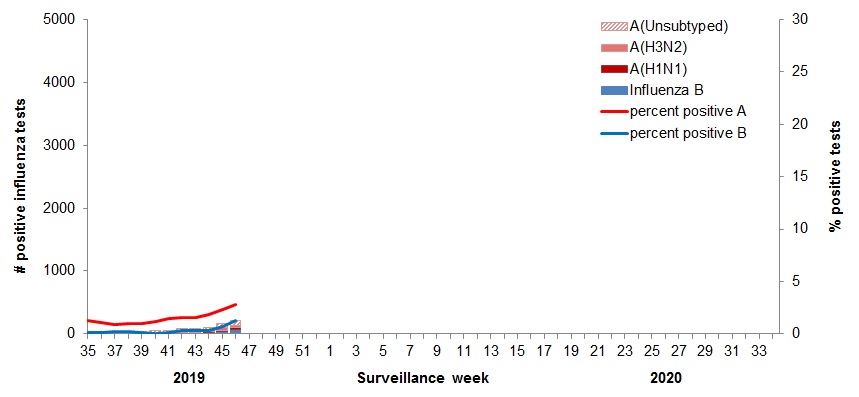
Figure 2 - Text equivalent
| Surveillance Week | A(Unsubtyped) | A(H3N2) | A(H1N1)pdm09 | Influenza B | Percent Positive A | Percent Positive B |
|---|---|---|---|---|---|---|
| 35 | 10 | 16 | 0 | 2 | 1.3 | 0.1 |
| 36 | 11 | 13 | 2 | 2 | 1.1 | 0.1 |
| 37 | 5 | 17 | 2 | 5 | 0.9 | 0.2 |
| 38 | 11 | 15 | 3 | 6 | 1.0 | 0.2 |
| 39 | 11 | 21 | 2 | 3 | 1.0 | 0.1 |
| 40 | 34 | 9 | 1 | 2 | 1.2 | 0.1 |
| 41 | 34 | 18 | 0 | 5 | 1.4 | 0.1 |
| 42 | 54 | 12 | 1 | 14 | 1.6 | 0.3 |
| 43 | 44 | 13 | 7 | 17 | 1.6 | 0.3 |
| 44 | 43 | 23 | 16 | 17 | 1.8 | 0.3 |
| 45 | 61 | 51 | 18 | 39 | 2.3 | 0.7 |
| 46 | 82 | 34 | 22 | 71 | 2.8 | 1.3 |
Figure 3 – Weekly and cumulative numbers of positive influenza specimens by type/subtype and province, Canada, 2019-2020, weeks 2019-35 to 2019-46
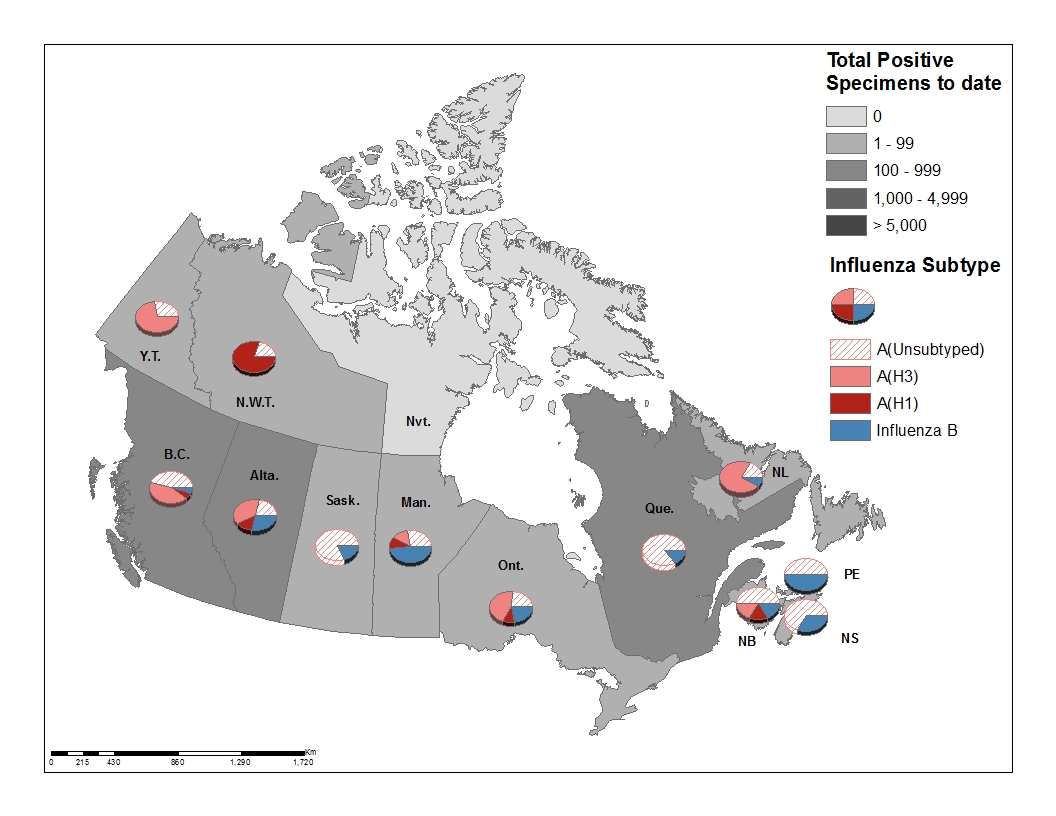
Figure 3 - Text equivalent
| ProvincesTable Figure 3 - Footnote 1 | Cumulative (August 25, 2019 to November 16, 2019) | |||||
|---|---|---|---|---|---|---|
| A Total | A(H1N1) | A(H3N2) | A(UnS)Table Figure 3 - Footnote 3 | B Total | A & B Total | |
| B.C. | 193 | 8 | 60 | 64 | 7 | 200 |
| Alta. | 224 | 44 | 114 | 66 | 89 | 313 |
| Sask. | 36 | 0 | 0 | 36 | 5 | 41 |
| Man. | 26 | 5 | 7 | 14 | 24 | 50 |
| Ont. | 77 | 11 | 42 | 24 | 22 | 99 |
| Que. | 170 | 0 | 0 | 170 | 28 | 198 |
| N.B. | 10 | 2 | 2 | 6 | 2 | 12 |
| N.S. | 2 | 0 | 0 | 2 | 1 | 3 |
| P.E.I. | 1 | 0 | 0 | 1 | 1 | 2 |
| N.L. | 11 | 0 | 9 | 2 | 1 | 12 |
| Y.T. | 11 | 0 | 8 | 3 | 0 | 11 |
| N.W.T | 5 | 4 | 0 | 1 | 0 | 5 |
| Nvt. | 0 | 0 | 0 | 0 | 0 | 0 |
| Canada | 766 | 74 | 242 | 389 | 180 | 946 |
| PercentageTable Figure 3 - Footnote 2 | 81% | 10% | 32% | 51% | 19% | 100% |
|
||||||
| Age groups (years) | Cumulative (August 25, 2019 to November 16, 2019) | ||||||
|---|---|---|---|---|---|---|---|
| Influenza A | B | Influenza A and B | |||||
| A Total | A(H1N1) | A(H3N2) | A (Un subtyped)Table 1 Footnote 1 | Total | # | % | |
| 0-4 | 72 | 15 | 23 | 34 | 25 | 97 | 13% |
| 5-19 | 62 | 4 | 25 | 33 | 58 | 120 | 16% |
| 20-44 | 108 | 16 | 33 | 59 | 59 | 167 | 22% |
| 45-64 | 125 | 24 | 44 | 57 | 11 | 136 | 18% |
| 65+ | 235 | 10 | 101 | 124 | 11 | 246 | 32% |
| Total | 602 | 69 | 226 | 307 | 164 | 766 | 100% |
|
|||||||
Syndromic / Influenza-like Illness Surveillance
Healthcare Professionals Sentinel Syndromic Surveillance
In week 46, 1.5%, of visits to healthcare professionals were due to influenza-like illness (ILI) which is similar to the average for this time of year (1.4%) (Figure 4).
Figure 4 – Percentage of visits for ILI reported by sentinels by report week, Canada, weeks 2019-35 to 2019-46
Number of participants reporting in week 46: 78
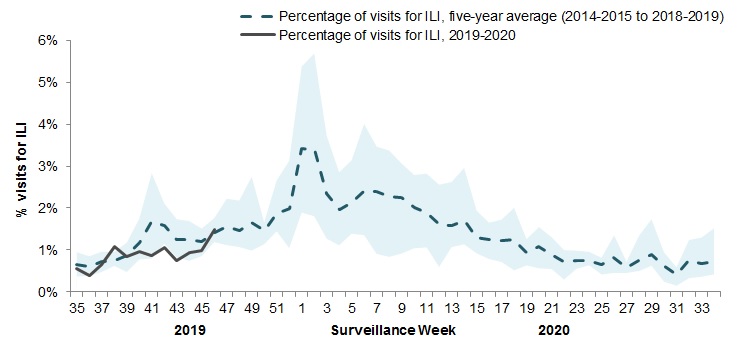
The shaded area represents the maximum and minimum percentage of visits for ILI reported by week from seasons 2014-2015 to 2018-2019
Figure 4 - Text equivalent
| Surveillance Week | 2019-20 | Average | Min | Max |
|---|---|---|---|---|
| 35 | 0.6% | 0.6% | 0.4% | 0.9% |
| 36 | 0.4% | 0.6% | 0.4% | 0.9% |
| 37 | 0.7% | 0.7% | 0.5% | 1.0% |
| 38 | 1.1% | 0.7% | 0.6% | 1.0% |
| 39 | 0.8% | 0.9% | 0.5% | 1.2% |
| 40 | 1.0% | 1.2% | 0.8% | 1.7% |
| 41 | 0.9% | 1.7% | 0.8% | 2.8% |
| 42 | 1.1% | 1.6% | 1.2% | 2.1% |
| 43 | 0.7% | 1.2% | 0.8% | 1.7% |
| 44 | 0.9% | 1.2% | 0.7% | 1.7% |
| 45 | 1.0% | 1.2% | 0.9% | 1.5% |
| 46 | 1.5% | 1.4% | 1.2% | 1.8% |
FluWatchers
In week 46, 3,010 participants reported to FluWatchers, of which 1.2% (37) reported symptoms of cough and fever (Figure 5).
Among the 37 participants who reported cough and fever:
- 14% consulted a healthcare professional;
- 68% reported days missed from work or school, resulting in a combined total of 77 missed days of work or school.
- 57% reported having been vaccinated for influenza this season.
If you are interested in becoming a FluWatcher, sign up today.
Figure 5 - Percentage of participants reporting fever and cough, Canada, 2019-2020, weeks 2019-40 to 2019-46
Number of Participants Reporting in Week 46: 3,010

Figure 5 - Text equivalent
| Surveillance Week | % cough and fever |
|---|---|
| 40 | 2.2% |
| 41 | 1.8% |
| 42 | 1.7% |
| 43 | 2.2% |
| 44 | 1.6% |
| 45 | 1.4% |
| 46 | 1.2% |
Online Figure – Geographic distribution of FluWatchers participants reporting cough and fever, Canada, week 2019-46
Click on the map to access the link
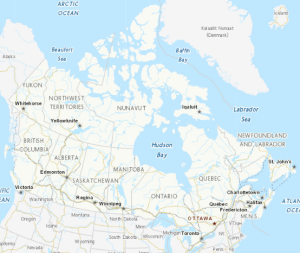
Influenza Outbreak Surveillance
In week 46, four new outbreaks were reported: three in a long term care facility and one in an acute care facility. (Figure 6).
To date this season, a total of 20 laboratory-confirmed influenza outbreaks have been reported; eleven in long-term care facilities, two in acute care facilities and seven in a facility type categorized as ‘other’, which includes facilities such as private personal care homes, correctional facilities, and colleges/universities. Of the outbreaks where influenza type was reported (18), seventeen were due to influenza A. Among the 10 outbreaks for which the influenza A subtype was reported, all were associated with A(H3N2). One ILI outbreak in a school/daycare has also been reported.
Figure 6 – Number of new outbreaks of laboratory-confirmed influenza by report week, Canada, weeks 2019-35 to 2019-46
Number of provinces and territories reporting in week 46: 12 out of 13
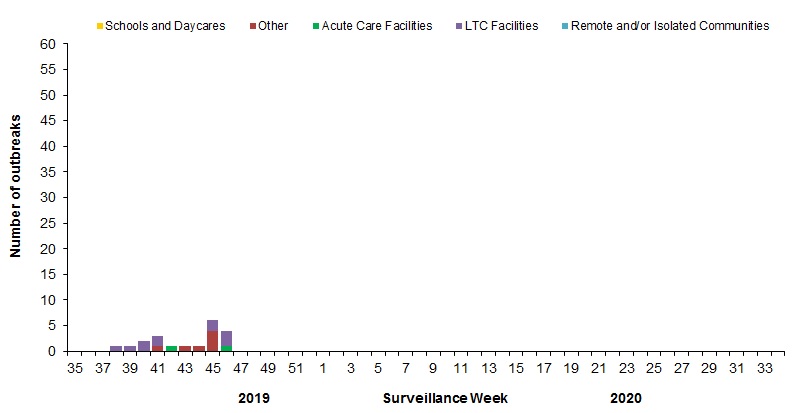
Figure 6 - Text equivalent
| Surveillance Week | Acute Care Facilities | Long Term Care Facilities | Other | Schools and Daycares | Remote and/or Isolated Communities |
|---|---|---|---|---|---|
| 35 | 0 | 0 | 0 | 0 | 0 |
| 36 | 0 | 0 | 0 | 0 | 0 |
| 37 | 0 | 0 | 0 | 0 | 0 |
| 38 | 0 | 1 | 0 | 0 | 0 |
| 39 | 0 | 1 | 0 | 0 | 0 |
| 40 | 0 | 2 | 0 | 0 | 0 |
| 41 | 0 | 2 | 1 | 0 | 0 |
| 42 | 1 | 0 | 0 | 0 | 0 |
| 43 | 0 | 0 | 1 | 0 | 0 |
| 44 | 0 | 0 | 1 | 0 | 0 |
| 45 | 0 | 2 | 4 | 0 | 0 |
| 46 | 1 | 3 | 0 | 0 | 0 |
Severe Outcomes Influenza Surveillance
Provincial/Territorial Influenza Hospitalizations and Deaths
To date this season. 77 influenza-associated hospitalizations were reported by participating provinces and territoriesFootnote 1.
- 90% of the cases were influenza A.
- Of the cases for which subtype was reported (60), 77% were associated with influenza A(H3N2).
- The greatest proportion of hospitalizations (43%) were amongst adults ≥ 65 years of age.
Seven ICU admissions and no deaths have been reported.
Number of provinces and territories reporting in week 46: 9 out of 9- Footnote 1
-
Influenza-associated hospitalizations are reported by N.L., P.E.I. N.S., N.B., Man., Alb., Y.T. and N.W.T. Only hospitalizations that require intensive medical care are reported by Sask. The cumulative rate of hospitalizations is calculated using the population by age-group in participating provinces and territories.
Pediatric Influenza Hospitalizations and Deaths
In week 46, six pediatric (≤16 years of age) laboratory-confirmed influenza-associated hospitalizations were reported by the Immunization Monitoring Program Active (IMPACT) network (Figure 7). This is slightly below the average (13) for week 46 over the previous five seasons.
To date this season, 17 pediatric hospitalizations have been reported by the IMPACT network; 11 cases associated with influenza A and 6 with influenza B. Among the five cases for which the influenza A subtype was reported, all were associated with A(H1N1).
Figure 7 – Number of pediatric (≤16 years of age) hospitalizations reported by the IMPACT network, by week, Canada, weeks 2019-35 to 2019-46

The shaded area represents the maximum and minimum number of cases reported by week from seasons 2014-15 to 2018-19
Figure 7 - Text equivalent
| Surveillance week | 2019-2020 | Average | Min | Max |
|---|---|---|---|---|
| 35 | 0 | 0 | 0 | 1 |
| 36 | 2 | 0 | 0 | 1 |
| 37 | 0 | 1 | 0 | 2 |
| 38 | 0 | 1 | 0 | 2 |
| 39 | 1 | 1 | 0 | 3 |
| 40 | 0 | 1 | 0 | 2 |
| 41 | 2 | 1 | 0 | 3 |
| 42 | 2 | 2 | 0 | 5 |
| 43 | 3 | 5 | 2 | 12 |
| 44 | 1 | 5 | 1 | 15 |
| 45 | 1 | 10 | 2 | 37 |
| 46 | 6 | 13 | 1 | 41 |
Adult Influenza Hospitalizations and Deaths
Surveillance of laboratory-confirmed influenza-associated adult (≥16 years of age) hospitalizations by the Canadian Immunization Research Network (CIRN) Serious Outcomes Surveillance (SOS) network began on November 1st for the 2019-20 season. To date this season, fewer than five cases have been reported.
Influenza Strain Characterizations
From September 1 to November 21, 2019, the National Microbiology Laboratory (NML) has characterized 45 influenza viruses (28 A(H3N2), 8 A(H1N1) and 9 influenza B) that were received from Canadian laboratories.
Influenza A(H3N2)
Over recent years, circulating strains of A(H3N2) have evolved, and are increasingly difficult to characterize by hemagglutination inhibition (HI) assay. Genetic characterization is established by sequencing the hemagglutinin (HA) gene of the influenza viruses to compare their genetic properties.
Antigenic Characterization:
Among the eight influenza A(H3N2) viruses antigenically characterized to date:
- Seven A(H3N2) viruses showed reduced titer by HI assay to A Kansas/14/2017 using antiserum raised against egg-propagated A Kansas/14/2017.
- One A(H3N2) virus was antigenically similar to A Kansas/14/2017 by HI assay.
Genetic Characterization:
All 28 A(H3N2) viruses this season have been genetically characterized, based on sequence analysis of the HA gene.
- Among the 8 A(H3N2) viruses antigenically characterized:
- Seven viruses belonged to genetic group 3C.2a1b.
- One virus belonged to the genetic group 3C.3a.
- Among the 20 A(H3N2) viruses which did not grow to sufficient hemagglutination titer for antigenic characterization by HI assay:
- All viruses belonged to genetic subclade 3C.2a1b.
A/Kansas/14/2017 belongs to genetic group 3C.3a and is the influenza A(H3N2) component of the 2019-20 Northern Hemisphere influenza vaccine.
Influenza A(H1N1)
- All eight A(H1N1) viruses characterized were antigenically similar to A/Brisbane/02/2018 by HI testing using antiserum raised against egg-propagated A/Brisbane/02/2018.
A/Brisbane/02/2018 is the influenza A(H1N1) component of the 2019-20 Northern Hemisphere influenza vaccine.
Influenza B
Of the nine influenza B viruses antigenically characterized this season:
- Seven influenza B viruses showed reduced titer by HI assay to B/Colorado/06/2017 using antiserum raised against cell culture-propagated B/Colorado/06/2017. Sequence analysis showed that :
- All of these viruses had a three amino acid deletion (162-164) in the HA gene.
- Two influenza B viruses were antigenically similar to B/Colorado/06/2017 by HI assay.
The recommended influenza B components for the 2019-20 Northern Hemisphere influenza vaccine are B/Colorado/06/2017 (Victoria lineage) and B/Phuket/3073/2013 (Yamagata lineage). B/Phuket/3073/2013 is included in the quadrivalent influenza vaccine.
Antiviral Resistance
The National Microbiology Laboratory (NML) also tests influenza viruses received from Canadian laboratories for antiviral resistance.
Oseltamivir:
44 influenza viruses (29 A(H3N2), 6 A(H1N1) and 9 B) were tested for resistance to oseltamivir:
- All influenza viruses tested were sensitive to oseltamivir.
Zanamivir:
44 influenza viruses (29 A(H3N2), 6 A(H1N1) and 9 B) were tested for resistance to zanamivir:
- All influenza viruses tested were sensitive to zanamivir.
Amantadine:
High levels of resistance to amantadine persist among influenza A(H1N1) and influenza A(H3N2) viruses. All viruses tested this season were resistant.
Vaccine Monitoring
Vaccine monitoring refers to activities related to the monitoring of influenza vaccine coverage and effectiveness.
Vaccine Coverage
Influenza vaccine coverage estimates for the 2019-20 season are anticipated to be available in February or March 2020.
Vaccine Effectiveness
Influenza vaccine effectiveness estimates for the 2019-20 season are anticipated to be available in February or March 2020.
Provincial and International Surveillance Links
- British Columbia – Influenza Surveillance; Vaccine Effectiveness Monitoring
- Alberta – Respiratory Virus Surveillance
- Saskatchewan – Influenza Reports
- Manitoba – Seasonal Influenza Reports
- Ontario – Ontario Respiratory Pathogen Bulletin
- Québec – Système de surveillance de la grippe (available in French only)
- New Brunswick – Influenza Surveillance Reports
- Prince Edward Island – Influenza Summary
- Nova Scotia – Respiratory Watch Report
- Newfoundland and Labrador – Surveillance and Disease Reports
- Yukon – Information on Pandemic, Influenza, Seasonal Flu, Avian Flu and H1N1
- Northwest Territories – Influenza/ Flu Information
- Nunavut – Influenza Information
- World Health Organization – FluNet (Global Influenza Surveillance Network)
- Pan American Health Organization – Influenza situation report
- U.S. Centers for Disease Prevention & Control (CDC) - Weekly Influenza Summary Update
- ECDC – Surveillance reports and disease data on seasonal influenza
- United Kingdom – Weekly Influenza Activity Reports
- Hong Kong Centre for Health Protection - Flu Express
- Australia – Influenza Surveillance Report and Activity Updates
- New Zealand – Influenza Weekly Update
Notes
The data in the FluWatch report represent surveillance data available at the time of writing. All data are preliminary and may change as more reports are received.
To learn more about the FluWatch program, see the Overview of influenza monitoring in Canada page.
For more information on the flu, see our Flu (influenza) web page.
We would like to thank all the Fluwatch surveillance partners participating in this year's influenza surveillance program.
This report is available on the Government of Canada Influenza webpage.
Ce rapport est disponible dans les deux langues officielles.